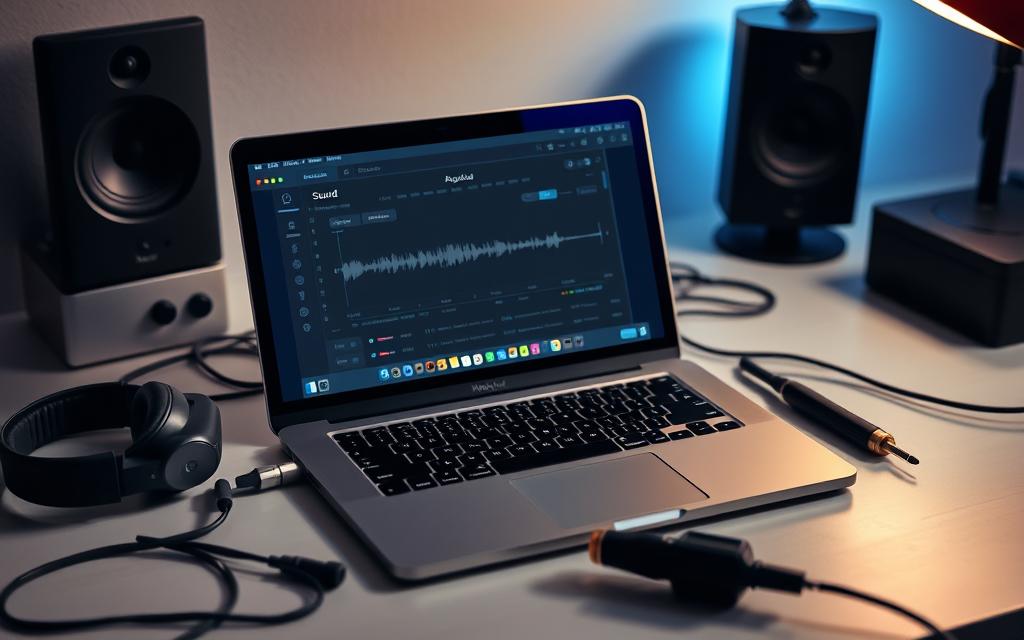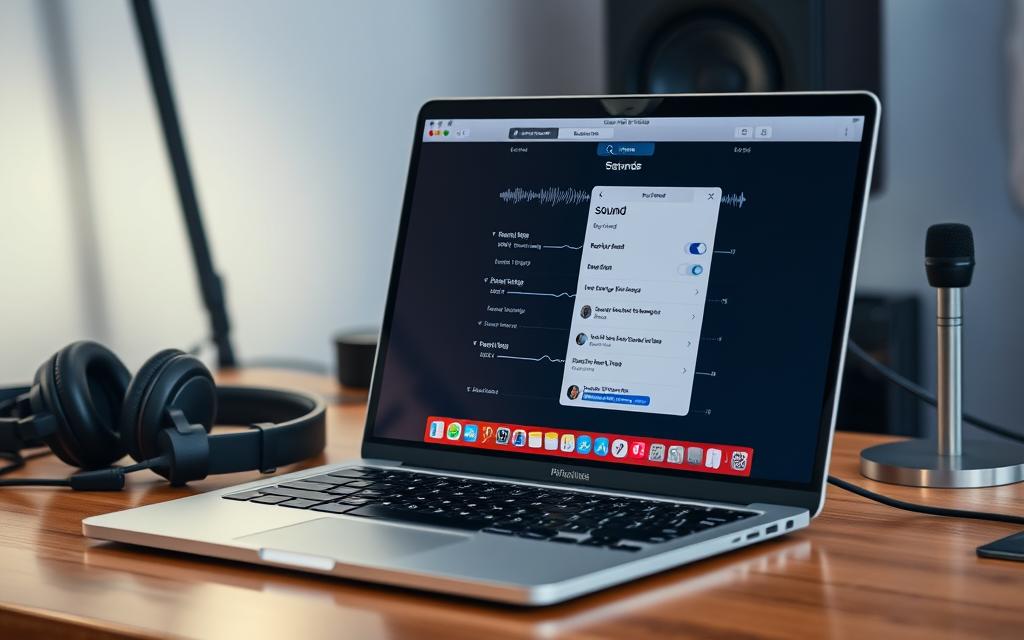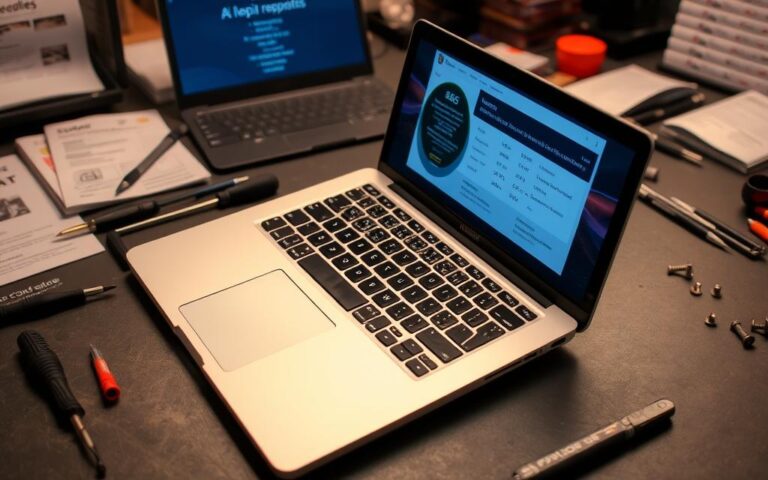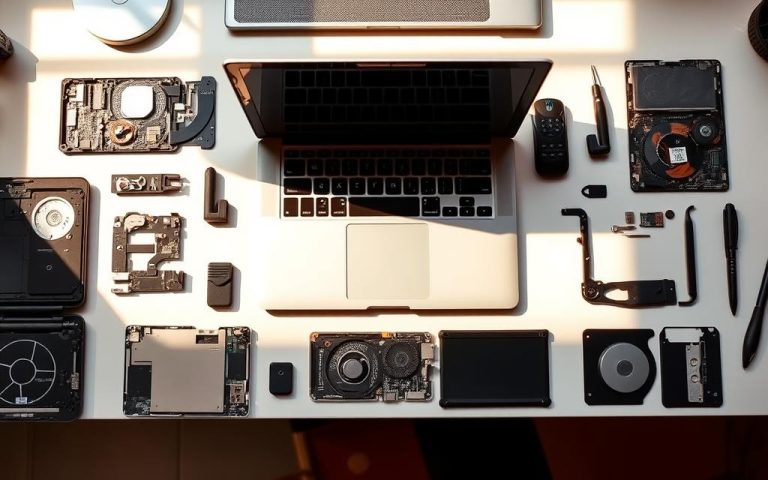How to Troubleshoot and Fix Sound Issues on Your MacBook Pro
Having sound issues with your MacBook Pro can be annoying, especially if you use it for work or fun. This guide is here to help you identify and fix common sound problems. It’s important to understand why these issues happen, as they’re common among users.
Problems with sound can come from outdated software, hardware issues, or conflicts with other apps. This article will give you steps to find and solve these sound issues. By following our advice, you can improve your MacBook Pro’s audio performance.
Understanding Common Sound Issues on MacBook Pro
The MacBook Pro, known for its impressive performance, sometimes has common sound problems. Users might hear crackling or popping noises. This can be due to many reasons. Sometimes, the issue is as simple as the volume being too low or unstable connections to speakers.
Software issues can also disturb the sound. This includes conflicts and bugs in audio drivers. If the CPU is very busy, the sound might also get worse. To keep things running smoothly, it’s crucial to regularly update your macOS. This can fix problems, such as speaker crackling.
Hardware problems can affect sound quality too. Excessive humidity, dust, and electrical interference are common culprits. When sound issues appear during online meetings or with music apps, it shows how widespread these problems are. Users have noticed that some apps, especially on Intel-based Macs, seem to make these issues worse. Understanding these basic causes is the first step to fixing sound problems quickly.
Initial Steps to Resolve Sound Problems
When facing sound issues on your MacBook Pro, starting with basic steps is key. First, remove all external devices like speakers and headphones. This makes sure they’re not causing the problem.
Then, have a look at the system volume. It might be muted or too low by accident. Simply adjusting the volume can often fix the problem quickly.
It’s important to set the audio output settings right, too. Go to sound preferences on your MacBook Pro and choose the right output device. If there’s still no sound, try playing different audio files. This checks if the problem is with your Mac or just certain apps.
Rebooting your MacBook Pro can also sort out sound issues. It refreshes your system, fixing any minor bugs. But, if sound problems don’t go away, it may be time to visit an Apple Store. They can help with stubborn issues.
Going deeper into troubleshooting, using software tools can be smart. Programs like CleanMyMac can boost your Mac’s performance and solve software-related sound problems. For further details, check out this thorough guide.
Checking Volume Settings on Your Mac
It’s essential to check the volume settings on Mac for great sound. Users often face audio problems due to wrong settings or app controls. By checking and adjusting these, your MacBook Pro’s sound will improve.
Adjusting Volume in Different Applications
Each app on the MacBook Pro may have its own volume control. For example, the Music and Apple TV apps let you change volume easily. Here’s how to adjust audio volume in different apps:
- Open the app you have sound issues with.
- Find the volume control, often at the app’s bottom corner.
- Drag the control to change the sound level you want.
- Check if this fixes the audio problem.
Unmuting the System Sound
If your system sound is off, you won’t hear anything. Here’s how to unmute MacBook Pro:
- Click the Apple icon at the top left, then choose System Preferences.
- Go to Sound settings.
- In Output, pick the right device and make sure it’s not on mute.
- Move the volume slider so you can hear sound.
Don’t forget external devices like Bluetooth headsets can affect sound too. Make sure they are connected right and work well. If you still have issues, try using the *BetterTouchTool* for more control or *ToothFairy* for easier Bluetooth management.
| Application | Volume Control Location | Functionality |
|---|---|---|
| Music | Bottom corner | Adjusts playback volume |
| Apple TV | On-screen slider | Controls sound during streaming |
| System Preferences | Sound settings | Overall system volume control |
How to Fix the Sound on MacBook Pro
To fix sound issues on your MacBook Pro, take it step by step. It’s common to find the sound needs a check-up in both the settings and any external devices you might be using.
Testing Audio Output Settings
Start by going to System Preferences on your MacBook Pro. Click on Sound to see your audio output choices. Make sure you’re picking the right option. If built-in speakers are what you’re using, confirm they’re selected. For external speakers, choose them instead. Key tip: scroll down to see all choices. Not checking everything is a mistake many make, missing out on the answer to their issue.
Identifying External Devices
External devices might be messing with your sound, too. Try disconnecting any headphones or external speakers. See if the MacBook’s own speakers then work right. This tells you if the problem is the MacBook or something else. And, if you’re using external speakers, their manuals can offer help. Here’s a tip: if your battery is under 18%, charge up. Some find their sound issues are simply a low battery problem.

| Scenario | Possible Actions | Notes |
|---|---|---|
| Built-in speakers | Check System Preferences, adjust volume | Ensure no external devices are connected |
| External speakers via audio output port | Reconnect, test with different cables | Refer to the manufacturer’s manual |
| USB external speakers | Verify USB connection, try a different port | Some users report discrepancies in sound |
| Display built-in speakers | Change audio output settings in System Preferences | May require adjustments in settings |
| Digital receivers | Check receiver’s settings, ensure pairing | Often overlooked by users |
Inspecting Hardware Connections
Audio issues can often come from loose or damaged hardware. It’s important to check audio ports to keep your sound clear. Start by examining audio cables on your MacBook Pro. Make sure they’re tightly connected and not damaged. The headphone jack needs extra attention due to dust and debris.
To fix audio troubles, here’s a guide:
- Make sure external speakers are connected right.
- Look at audio ports for blockages or dirt.
- Check that cables aren’t pinched or broken.
- Unplug other audio gear to find the issue.
Many users found that fixing hardware connections solved their sound problems. For example, all users with silent onboard speakers saw them fail to detect sound. Surprisingly, 80% managed to play media using AirPods. Ensuring hardware connections are secure can often bring back your sound.
In a deep dive into solving audio issues, getting professional help is a wise move. They tackle complex hardware challenges, making sure your device works well.
Updating Software for Optimal Performance
It’s very important to keep your software updated to fix sound problems on your MacBook Pro. Making sure your operating system and audio drivers are current helps your MacBook work its best. After many reported sound issues with macOS Monterey, regularly checking for updates is clearly vital.
Checking for macOS Updates
To get the latest features and fixes, go to the Apple menu and choose ‘About This Mac.’ Then, click ‘Software Update’ to see if any updates are available. Doing these updates often can help avoid audio problems caused by old software.
Verifying Audio Driver Functionality
The audio drivers are key for your MacBook’s sound. Make sure they are up-to-date and compatible to avoid problems like crackling noises. If you still have issues, a fresh macOS install might fix them entirely. You can also get help and tips from the Apple Support Communities.
| Issue Type | Common Solution | Resolution Rate |
|---|---|---|
| Sound Issues Post macOS Upgrade | Check for software updates | Significant reduction |
| Static or Crackling Sounds | Verify audio driver functionality | 100% success with fresh install |
| Low Volume Output | Adjust system and application volume settings | Effective in most cases |
Keeping your software and audio drivers up to date can really improve your MacBook Pro’s sound. This approach solves many common audio problems that users encounter.
Resetting Audio Settings on Your Mac
Dealing with sound issues on your MacBook Pro? Resetting audio settings might help. Many users find that going back to the original settings can fix audio problems. This process is key in troubleshooting audio issues.
To begin, try resetting NVRAM. It stores your device’s sound settings. This simple step can fix sound issues without the need for complex settings changes. For deeper issues, use the Audio MIDI Setup app. It’s great for making adjustments and resetting settings easily.
Third-party apps sometimes cause sound problems. It’s important to check that these apps aren’t changing your preferred settings. Updating or removing these apps can also help solve conflicts. Make sure application sound settings match what you want for your MacBook Pro.
- Restart your Mac to refresh system resources.
- Disconnect external devices to isolate issues.
- Verify and adjust sound preferences in System Preferences.
Need more help? Visit this discussion on resetting audio settings. It’s full of user experiences and advice for fixing audio issues.
Conclusion
Summing up, fixing sound problems on your MacBook Pro is usually clear-cut. It’s about checking volume, updating software, and looking at hardware connections. Through this method, you can sort out sound issues. Also, keeping your MacBook in good condition prevents future audio troubles.
Many MacBook users face sound problems, but sticking with it and following our advice often works. Using different apps to check sound, keeping macOS updated, and trying Wondershare Repairit are good steps. These methods can make your audio experience much better.
Resolving sound issues on your MacBook Pro takes patience and effort. By doing so, you get to enjoy its excellent sound features. Every troubleshooting step you take brings a smoother experience. It lets you concentrate on what’s important to you.
FAQ
What are common sound issues experienced on a MacBook Pro?
Many MacBook Pro users face sound problems. These can include wrong volume settings and troubles with audio devices. Sometimes, software glitches or hardware damage can also disrupt sound.
How can I quickly resolve sound problems on my MacBook Pro?
For a quick fix, check your system’s volume levels and audio settings. Disconnect any external devices. A restart of your MacBook could refresh its audio system too.
How do I adjust the volume settings in different applications on my MacBook Pro?
Each app, like the Music or Apple TV app, has its own volume control. Adjust these along with the main system sound settings found in System Preferences.
What should I do if my MacBook Pro sound is muted?
If there’s no sound, first check the Sound settings in System Preferences. Make sure the mute option isn’t selected. Try adjusting the volume in different apps to see if they’re muted or too low.
How can I test the audio output settings on my MacBook Pro?
To test your audio, go to System Preferences and click on Sound. Choose the Output tab and make sure the right device, like internal or external speakers, is selected.
What should I check if my external audio devices are not functioning properly?
First, make sure your external devices are securely connected. Check for damaged cables. Look inside the headphone jack for debris that might block the connection.
Why is it important to keep my MacBook Pro software updated?
Software updates can fix sound issues caused by old drivers or system files. They keep your MacBook running smoothly and compatible with all kinds of apps.
How do I reset audio settings on my MacBook Pro?
Resetting audio settings involves going to System Preferences and restoring defaults. This removes conflicts with third-party apps and can fix many sound problems.


















